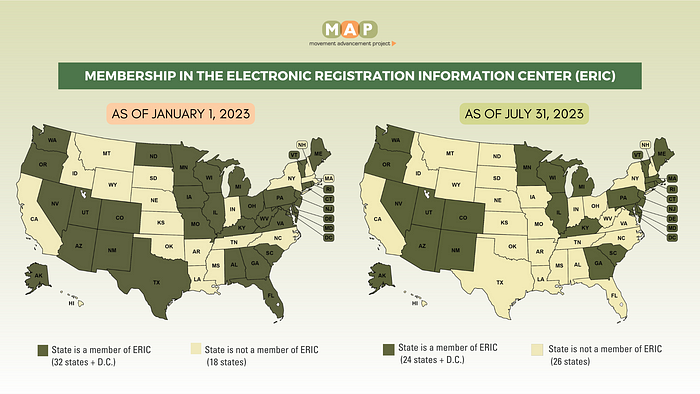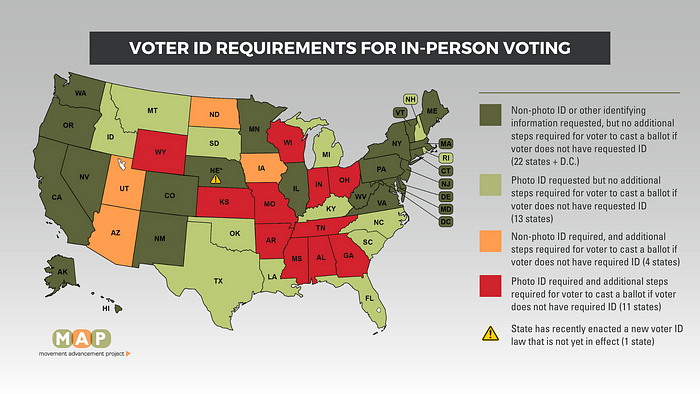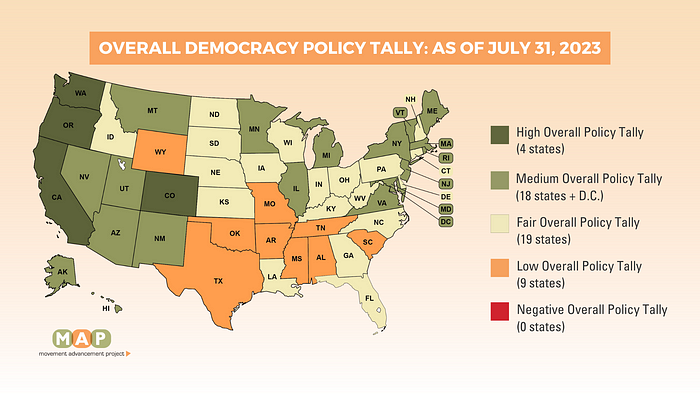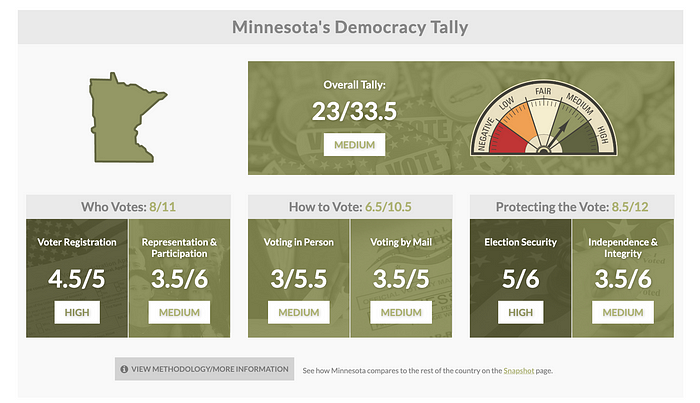Democracy Maps
State of Democracy: 2023 Mid-Year Legislative Wrap Up
How has the health of democracy changed in the states so far in 2023? Now that a majority of states have adjourned their legislative sessions, MAP is looking back at which states have seen the most change in 2023 in our Democracy Tally, both positive and negative, as well as examining policy trends in voting and elections. Our Democracy Maps project tracks 45 laws and policies related to elections and voting; together these make up each state’s Democracy Tally.
Election and Voting Policy Trends So Far in 2023
Declining Membership in the Electronic Registration Information Center
In a concerning trend that began at the end of last year, states continue to withdraw from membership in the Electronic Registration Information Center (ERIC), a nonpartisan organization created to assist states in maintaining accurate voter registration lists.

As of this writing, nine states have withdrawn from ERIC in the past year: Alabama, Florida, Iowa, Louisiana, Missouri, Ohio, Texas, Virginia and West Virginia. The recent exodus means that more than half of voters now live in states that are not part of ERIC.
In addition to these withdrawals, Oklahoma passed legislation that prohibits future membership in ERIC. As tracked on our map, 24 states and D.C. remain members of ERIC.
This trend is unfortunately likely to continue as states bow to political pressure and misinformation, despite the fact that ERIC is the best tool available to maintain accurate voter lists and prevent potential voter fraud.
Expanding Automatic Voter Registration
States continue to adopt automatic voter registration (AVR) at a steady pace over the past decade, which ultimately improves voter turnout. Of the two different methods of implementing AVR, back-end has a greater impact on increasing both election security and voter turnout.
Back-end AVR works by automatically registering voters when they interact with certain state agencies, like a DMV.
- Minnesota enacted back-end AVR this year.
- Nevada and Washington updated their AVR systems from front-end to back-end during this legislative session.
- Delaware and New York finished the implementation process for their AVR systems, meaning that eligible voters in those states will start to be automatically registered this year.
A total of 23 states have some form of automatic voter registration: eight of those states have back-end AVR and 15 states have front-end AVR.
Nearly half of voters live in a state with AVR but so far only 1 in 10 voters lives is a state with back-end AVR.
(For more detail, see MAP’s report, Automatic Voter Registration Best Practices in the States.)
Restoring of Voting Rights for Formerly Incarcerated People
As of this year 23 states restore voting rights automatically upon release from incarceration, and over half of all eligible voters live in a state with automatic restoration.
- Minnesota and New Mexico both enacted legislation this year that automatically restores voting rights upon release from incarceration to people disenfranchised due to previous felony convictions. These reforms could potentially impact 50,000 citizens in Minnesota and 17,500 citizens in New Mexico.
- Voters in North Carolina who were formerly incarcerated are no longer able to vote until they have completed probation or parole, following a state Supreme Court decision. This makes North Carolina the 14th state to impose these restrictions. An additional 11 states require people to take even further action to restore their voting rights.

Restrictions on Ballot Drop Boxes
Since the 2020 election when rates of mail voting skyrocketed, ballot drop boxes continue to be an area of focus for policymakers. Some politicians have tried to misrepresent drop boxes as contributing to voter fraud, allegations which have repeatedly been proven false. This led to a movement in Republican-led states to limit the availability of drop boxes or ban them entirely.
- This year Arkansas and South Dakota banned drop boxes entirely.
- Ohio passed legislation implementing severe restrictions on ballot drop boxes in the state, with only a single drop box now allowed per county.
- In a positive development, New Mexico codified the accessible use of drop boxes.
Currently, 11 states now ban the use of ballot drop boxes entirely. This means that more than 1 in 5 eligible voters — nearly 50 million voters — are denied access to this secure and simple method of returning their ballot.
See MAP’s policy brief on ballot drop boxes to learn more.

Voter Identification for In-Person Voting
Another trend continuing this year across the states is the adoption of stricter requirements for identification that voters must provide to vote in-person. Unnecessarily strict identification requirements create barriers for eligible voters who may not be able to obtain a specific form of required ID. These overly strict procedures usually require very limited forms of ID and/or burdensome additional steps to be taken by the voter after Election Day to ensure their vote is counted.

Currently 11 states require photo ID to vote. Four states require non-photo ID.
- Ohio enacted a strict photo ID requirement for in-person voting. According to a report from the Legal Aid Society of Cleveland, more than 1 million Ohioans had their driver’s licenses suspended in 2020; suspended licenses cannot be used as valid ID. This disproportionally impact low-income voters and communities of color.
- Nebraska enacted legislation that will require photo ID in order to vote in person. This follows following the passage of a ballot measure in 2022 that called for stricter voter ID requirements. The Nebraska law will go into effect in 2024.
- In North Carolina, a state Supreme Court ruling reinstated a photo voter ID law for in-person voting in the state. The law had previously been blocked on grounds of racial discrimination.
- Idaho enacted a law eliminating the use of student IDs as acceptable forms of identification for in-person voting.
- Michigan passed a law expanding the list of acceptable IDs to include student IDs. Michigan is one of 13 states that requests a photo ID for voters but does not require any additional steps if someone does not have ID.
Early Voting
- Connecticut passed legislation this year to establish early in-person voting for the first time in the state. Connecticut was previously only one of four remaining states that did not offer opportunities for early voting to all voters. The majority of U.S. voters (over 90%) live in states that offer early in-person voting.
State Voting Rights Act
- Connecticut is the seventh state to implement a state level voting rights act. The law includes pre-clearance provisions that apply to local jurisdictions with a history of discrimination, provides new avenues to contest discrimination against voters in court, expands language assistance, and strengthens protections against voter intimidation, among other provisions.
- This builds on a trend over the last four years, when three additional states also passed their own state level voting rights acts (Oregon, New York, and Virginia). These kinds of policies specifically prohibit racial discrimination in election administration.
- However, nearly 4 in 5 voters still live in a state that does not have a statewide voting rights act.
How State Democracy Tally Scores Change in 2023
Our Democracy Maps track 45 laws and policies related to elections and voting; together these make up each state’s Democracy Tally. We’re taking a snapshot look at which states had the most change in 2023 in our Democracy Tally.

How Each State Ranks for Overall Democracy Tally Score and How Many Voters Live in Those States
- High Democracy Tally (dark green): 4 states (38,909,971 voters)
- Medium Democracy Tally (light green): 18 states & D.C. (72,453,713 voters)
- Fair Democracy Tally (yellow): 19 states (71,727,059 voters)
- Low Democracy Tally (orange): 9 states (43,783,091 voters)
Four states saw significant shifts in their Democracy Tally Scores from January 1, 2023 to June 30, 2023; three states improved substantially while one saw significant backsliding.
Minnesota had the largest increase in its Democracy Score in the first half of 2023.
- Through the first half of 2023, Minnesota saw the greatest increase in its Democracy Score rising to 7th in the nation from 14th at the beginning of the year.

- The majority of the changes in Minnesota’s score the result of legislation that implemented voter pre-registration for 16-year-olds, a permanent absentee voter list, and back-end automatic voter registration, and automatic restoration of voting right for people who have served their time after a previous felony conviction.
Connecticut significantly improved its Democracy Score.
- Connecticut saw the second highest change to its Democracy Score in the first half of 2023, improving from 30th in the nation to 24th overall.

- This change is largely due to Connecticut passing a state level voting rights act and allowing early voting for the first time.
New Mexico’s Democracy Score increased this year.
- New Mexico’s Democracy Score improved this year, rising from 16th to 11th overall. This change was driven primarily by the passage of omnibus legislation containing a number of pro-voter reforms, including establishing a permanent absentee voter list and automatic restoration of voting rights after people with felony convictions have served their time.

Ohio had the largest decline in its Democracy Score so far in 2023.
- Ohio had the most significant decrease in our Democracy Tally Score through the first half of 2023. This is largely due to its new restrictive voter ID law and severe restrictions on ballot drop boxes.
- Nine additional states saw a decline in their Democracy Score due to passage of anti-democracy laws, including those that restrict voting rights.

Looking Forward
As some states continue to be in legislative session through the year ahead, MAP will continue tracking dozens of laws and policies about voting, democracy, and elections through our Democracy Maps, which are updated in real time.
